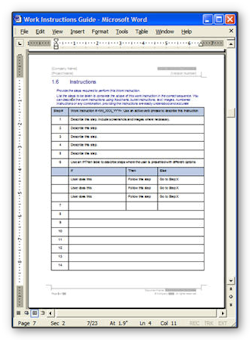How to Improve Your Work Instructions
Let's talk about Work Instructions. We all know that creating work instructions is tedious, and to make matters worse, often people don't even use them.
The Problem with Work Instructions
We all know how important work instructions are for training of manufacturing and service workers, yet the entire process is plagued with problems – from creating, to maintaining, to using work instructions.
all know how important work instructions are for training of manufacturing and service workers, yet the entire process is plagued with problems – from creating, to maintaining, to using work instructions.
Once written, work instructions are destined to be obsolete; it’s only a matter of when. So how are they maintained? A shop floor or a field service employee may change a procedure and never notify the person responsible for updating the work instructions – reality is not always documented.
Getting people to use the work instructions is the biggest problem. Most times they are just pages filed in binders. A set of work instructions for assembling a complex machine may be hundreds of pages long. As consumers, we joke about "not reading the instructions". Is it any different in the workplace?
So how do we improve the process for writing, maintaining, and accessing work instructions? See our tips below:
Ideas for Improving Work Instructions
- Integrated. Work instruction documentation should be tightly integrated with the part geometry. And they should be easy to create.
- Maintenance. For maintaining the work instructions, it should be easy enough that the service manager or manufacturing foreman can perform this function.
- “Bite-size”: The work instruction should be delivered in "bite-size" chunks pertaining exactly to the specific task at hand.
- Consumable. Work instructions need to be easy to consume, ideally from an electronic device. A range of choices should be available to fit most any environment.
- Animated. Animations should be embedded with the work instructions, so that the manufacturing or service personnel or customers could see exactly what is being performed.
- Useful. Make certain that the work instructions are useful to the end-user. These people are more motivated to provide feedback to the person responsible for maintaining the work instructions if the instructions are useful and needed.
Mitsubishi Agricultural Machinery: An Example

We published a recent story that showed how a well-known design and manufacturing company improved their work instructions process. The end result was that the improved work instruction process not only accelerated product design and manufacturing, it also helped them more easily pass experts skills from veteran workers to young workers.
Mitsubishi Agricultural Machinery (MAM), part of Mitsubishi Heavy Industry Group, designs, manufactures and sells agricultural machinery.
Using XVL from Lattice Technology, MAM dramatically changed the workflow of their assembly process and work instructions to take advantage of concurrent engineering. Visualization in 3D with the related instructions of the assembly process enables users to quickly and easily understand the process.
MAM implemented XVL Studio, Lattice Technology’s core authoring tool for turning 3D design data into 3D manufacturing data. XVL Studio enables digital manufacturing, digital mock-up (DMU) and technical illustration, across the enterprise–directly from 3D data.
With the new workflow, workers can simulate the process and consider the tooling and jigs needed by using the actual part geometry--even when the model is still in design.
“Introducing Lattice Technology’s XVL solution has resulted in motivation to change the workflow of the assembly process and work instructions,” said Masashi Kawamoto, Development Management Division at MAM. Kawamoto went on to say that feedback from assembly process designers has been positive. “They are pleased with the innovation of the XVL solution.”
